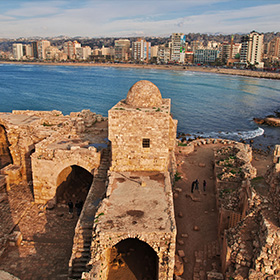 Lebanon’s rich and diverse geographical, cultural, social and religious landscape means that there will be something for everyone in this tiny nation. Home to the ancient Phoenician civilization which gave the world the alphabet, Lebanon occupied a crucial position along the Mediterranean.
Lebanon’s rich and diverse geographical, cultural, social and religious landscape means that there will be something for everyone in this tiny nation. Home to the ancient Phoenician civilization which gave the world the alphabet, Lebanon occupied a crucial position along the Mediterranean.
Lebanon’s diminutive size enables you to travel easily from the beaches of the capital Beirut to the famed mountains of Lebanon, which rise steeply
Perhaps, the most prominent shrine for the pilgrim is the famed Basilica and Statue of Our Lady of Lebanon in Harissa, a mountain village located 20 km north of Beirut.
The French-made statute has an overall height of 20 metres which includes a circling pathway which rises to the statue of Our Lady who is depicted with her arms outstretched overlooking the coast.
The papal embassy as well as the residences of four Eastern Catholic patriarchs may be found in the vicinity of the shrine. Both Pope John Paul II and Pope Benedict XVI visited the shrine during their respective pontificates.
Not too far from Harissa is the famed Jeita Grotto, a system of two limestone caves spanning an overall length of nearly 9kms.
The crystallised rock formations within these caves have led many to describe Jeita as a cathedral built by nature over the course of millions of years.
Continuing north, you will arrive at Byblos.
Believed to be the oldest continuously inhabited city in the world, it carries the remains of ancient Phoenician temples and Crusader forts and has been listed as a UNESCO World Heritage Site.
Continuing along these mountains of the northern parts of Lebanon, you will arrive at hallowed ground for Maronite Catholics who comprise the predominant Catholic group in Lebanon.
Here, high up in the open air and away from the noise and traffic of busy Beirut, are the shrines of three Lebanese saints – St Charbel, St Rafqa and St Neemtallah – who were canonized over the course of the past 40 years by Popes Paul VI and John Paul II.
Visiting the places where these saints lived and died, one’s spirit is lifted up to the heights of spiritual experience as one hears the silent voice of God whispering in the serenity of the mountains.
From the heights of the mountains to the depths of the valleys, the Lebanese have also sought to encounter the divine in the long, deep Qadisha Valley of northern Lebanon.
Here, evidence of monastic communities, often fleeing persecution, has been found since the earliest years of Christianity.
For this reason, it is also on the list of World Heritage sites. The Valley is near the Forest of the Cedars of God which contains cedars dating back to the ancient world when they were used by the Phoenicians and Egyptians for shipbuilding as well as by the Israelites under King Solomon to construct the first Temple in Jerusalem.
Moving from the North to the South of Lebanon, the country’s sectarian demography becomes readily apparent with Muslim majorities in the southern coastal cities of Tyre and Sidon.
Yet, these places carry great historical significance for Christians. Jesus traveled to this region where he healed the daughter of the Syro-phonecian woman.
This was the same area where God sent Elijah to comfort the widow.
Paul, returning to Palestine from his third missionary journey, sailed into Tyre where he met with a group of disciples.
If you are after a faith-filled pilgrimage that will also give you an insight into Mediterranean history, culture and cuisine, then look no further than Lebanon.